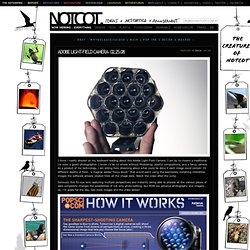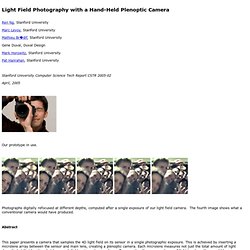

Adobe Light-Field Camera. I think i nearly drooled on my keyboard reading about this Adobe Light-Field Camera.

I am by no means a traditional (or even a good) photographer. I know i’d be no where without Photoshop, playful compositions, and a fancy camera. As a product of my technology, i am sitting here dreaming about what could be done if each image could contain 19 different depths of field… a magical adobe “focus brush” that would paint using the seemlessly morphing interstitial images the software already created from all the image data. Watch the video after the jump. Seriously this fly-eye lens capturing multiple perspectives and instantly being able to process all the various pieces of data completely changes the possibilities of not only photo-editing, but HOW we perceive photography and imagery… ok, i’m giddy for the day. Todor Georgiev - Photoshop - Adobe.
Amit Agrawal: Building A Hand-held Light Field Camera. Light Field Datasets Now you can convert your medium format digital/film camera into a 4D light field camera.

And that too in 5 minutes costing less than 5 dollars. Sounds fun. Lets see how we did it. What is a Light Field Camera? Recently, there is a great enthusiam about Lytro, the first company to offer a commercial light-field camera. A Light Field camera captures the variations in the rays falling on the sensor. The ray-space is four dimensional. How can we capture the Light Field? There are several ways to capture the light field. The above approaches are based on refractive elements. As shown in the video and figure above, we used a Mamiya 645ZD medium format camera with a 22 mega-pixel sensor digital back having a 36mm by 48mm Dalsa CCD imaging sensor. Mask Printing: We printed the mask at local printing company (Pageworks).
What are the advantages and disadvantages of using masks for light field capture? Light field capture using masks has several advantages. 1. 2. References: Light Field Photography with a Hand-Held Plenoptic Camera. Light Field Photography with a Hand-Held Plenoptic Camera Ren Ng, Stanford University Marc Levoy, Stanford University Mathieu Brdif, Stanford University Gene Duval, Duval Design Mark Horowitz, Stanford University Pat Hanrahan, Stanford University Stanford University Computer Science Tech Report CSTR 2005-02 April, 2005 Our prototype in use.

Photographs digitally refocused at different depths, computed after a single exposure of our light field camera. Abstract This paper presents a camera that samples the 4D light field on its sensor in a single photographic exposure. To the photographer, the plenoptic camera operates exactly like an ordinary hand-held camera. Tech Report 150 dpi (1 MB) Video AVI (74.4 MB) Uses XVid codec. Plenoptic camera. Front and back of a Lytro, the first consumer light-field camera, showing the front lens and LCD touchscreen.

A light-field camera, also called a plenoptic camera, is a camera that uses a microlens array to capture 4D light field information about a scene. Such light field information can be used to improve the solution of computer graphics and computer vision-related problems, and to make digital plenoptic pictures that can be refocused after they are taken. Technology[edit] The first light-field camera was proposed by Gabriel Lippmann in 1908, which used integral photography as the underlying technology. In 1992, Adelson and Wang proposed the design of a plenoptic camera that can be used to significantly reduce the correspondence problem in stereo matching.[1] To achieve this, an array of microlenses is placed at the focal plane of the camera main lens.
Image refocusing[edit] Stereo with plenoptic cameras[edit] Manufacturers of light-field cameras[edit] Light Field camera.